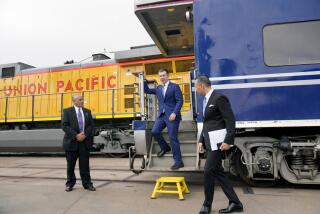California bullet train faces tough vote in Senate
Gov. Jerry Brown’s request for $6 billion to start construction of the California bullet train will face a difficult vote in the Legislature in the coming days, prompting some last-minute political maneuvering that could significantly alter the structure of the project.
Brown is seeking approval of a long-standing plan to build 130 miles of rail in the Central Valley from Bakersfield to Madera, creating the backbone of a future rail network that would later connect with Los Angeles and San Francisco.
But the plan has met growing skepticism among some legislators who say it would put the bulk of the initial funding in a low-ridership area that would have little independent value until the full system is completed. An alternative is being crafted to change the geographic distribution of the funds.
The existing plan is expected to easily pass the Assembly when it is taken up this week or possibly next, but the Senate is a different matter. Brown needs 21 of the 25 majority Democrats in the Senate to get his funding, a high bar given growing criticism within his own party. No Republican is expected to vote for the project.
“It will be a tight vote,” said Senate President Pro Tem Darrell Steinberg (D-Sacramento). “It’s a tough vote. I can’t predict the outcome, but I’m personally committed to it.”
If he had his way, Steinberg said, he wouldn’t start the project in the Central Valley either. Nonetheless, he’s still a supporter of the plan. “There is greater risk in not moving forward,” he said.
Steinberg said there are still discussions with colleagues on how to proceed, appearing to leave open some room for a compromise.
The skeptics in the Senate say privately that they are coming under enormous political pressure from organized labor, Rep. Nancy Pelosi (D-San Francisco) and the Obama administration, which plans to contribute $3.3 billion to the work. Whether they will fall in line with their party is unclear.
“The votes are not there,” said Sen. Mark DeSaulnier (D-Concord), chairman of the Senate Transportation Committee. “I am a ‘no’ at this time.”
“I don’t think there are 21 votes in the Senate until people have a chance to examine their options,” said Sen. Alan Lowenthal (D-Long Beach), chairman of a special committee on the high-speed rail project.
Sen. Joseph Simitian (D-Palo Alto), a third member who has closely studied the project, has not declared his opposition to Brown’s plan, but he has said he shares the same concerns that Lowenthal and DeSaulnier have. Simitian is running for a county supervisor post that would require him to eventually give up his seat in the Legislature if elected, so he may be unencumbered in his decision.
In the backrooms of the Capitol, a Plan B is being created that would shift significant funding out of the Central Valley. For months, critics have questioned why the project is starting there. The answer has been that the Federal Railroad Administration wants it to start there and the U.S. Transportation Department has threatened to rescind the federal money if the state tries to upset the apple cart.
But a close examination of the grant agreements is leading state lawmakers to believe they are free to spend funding granted under the American Recovery and Reinvestment Act of 2009 anywhere within four segments of the project, including one between San Francisco and San Jose and another between Los Angeles and Anaheim. The only segment that would be built in the Central Valley would run from Madera to Fresno, accounting for roughly 26 miles of roadbed.
“A Plan B would be to invest where the riders are and where we will be able to attract private equity much sooner,” DeSaulnier said.
Sen. Lou Correa (D-Santa Ana) also supports a new approach, saying, “My thoughts are very similar to Sen. DeSaulnier’s. My priority is to create jobs here in Orange County and to invest tax dollars where we get the biggest bang for the buck. Anaheim-Los Angeles and San Francisco-San Jose are the places. If we don’t focus on the L.A.-Anaheim corridor, there is no reason for me to go up on this vote.”
It is unlikely that the Obama administration will readily go along. Organized labor doesn’t like the idea either.
James Earp, a member of the California Transportation Commission and a labor leader who helped orchestrate the 2008 campaign for the state’s high-speed rail bond measure, said he would oppose such a move because it could jeopardize federal support for the entire project.
On the flip side, however, are critics who say Brown’s commitment to a now-unpopular bullet train project is jeopardizing his effort to persuade voters to approve a separate state tax increase this fall to help balance the state budget and fund schools.
Kris Vosburgh, executive director of the Howard Jarvis Taxpayers Assn., said he would use the bullet train project in the group’s campaign against the tax increase.
“This is clearly a bad project,” he said. “I am sure it will be mentioned in our campaign.”
Vartabedian reported from Los Angeles and Megerian from Sacramento.
More to Read
Sign up for Essential California
The most important California stories and recommendations in your inbox every morning.
You may occasionally receive promotional content from the Los Angeles Times.











